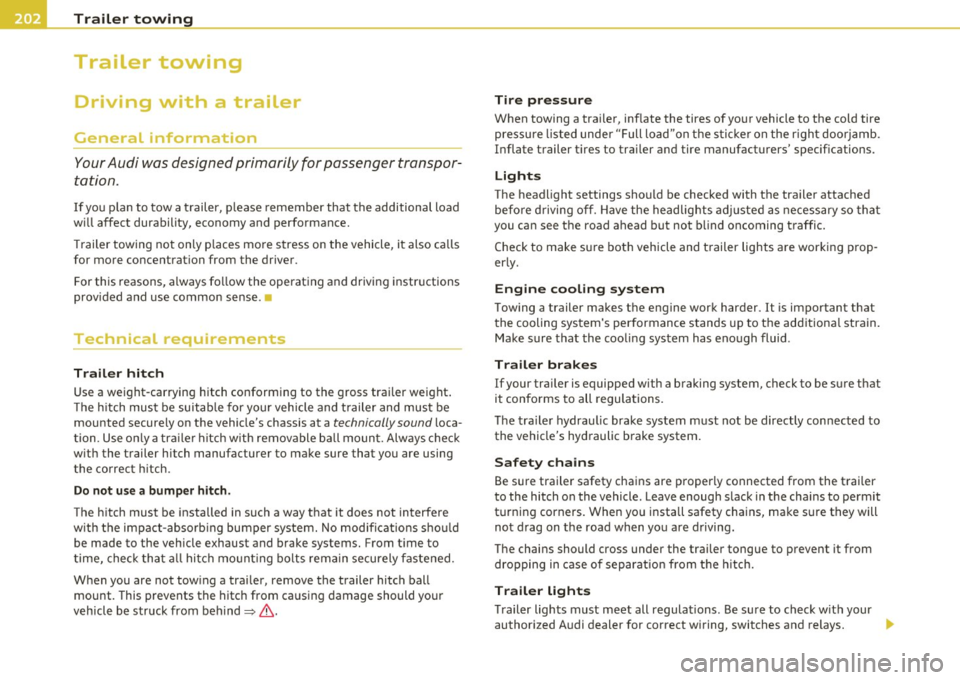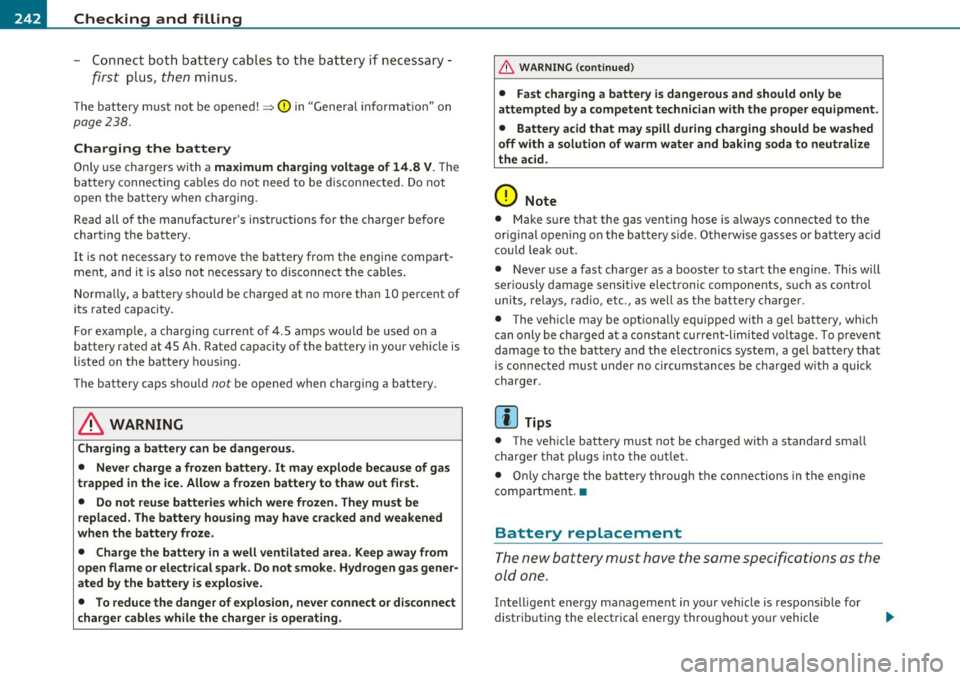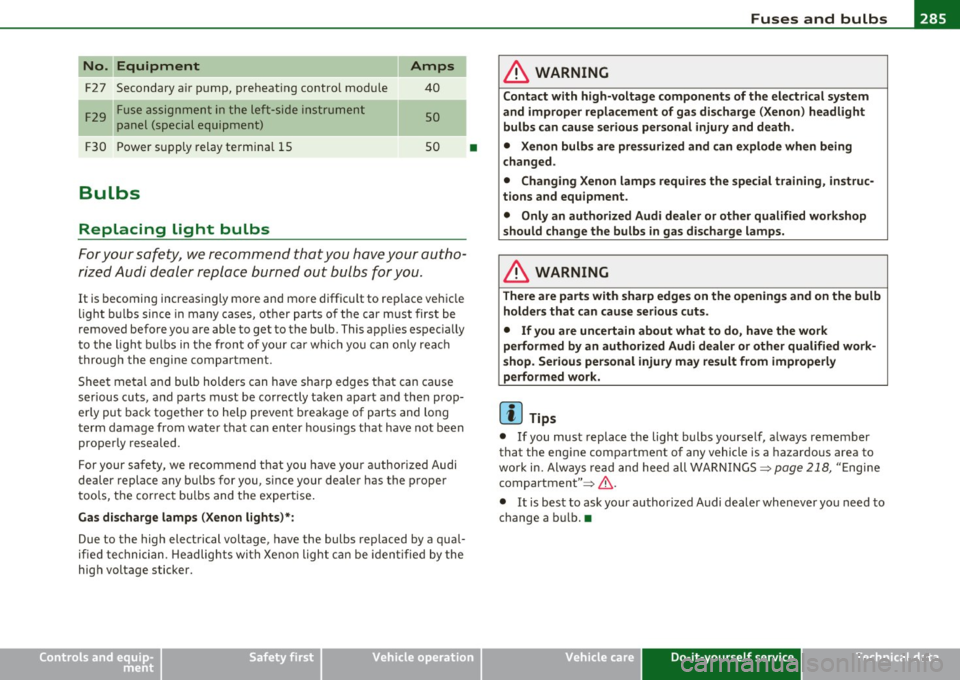relay AUDI A3 2011 Owner´s Manual
[x] Cancel search | Manufacturer: AUDI, Model Year: 2011, Model line: A3, Model: AUDI A3 2011Pages: 320, PDF Size: 75.79 MB
Page 204 of 320

Trailer towing
"---------------------------------------------------
Trailer towing
Driving with a trailer
General information
Your Audi was designed primarily for passenger transpor
tation .
If you p lan to tow a t railer, p lease remember that the additional load
w ill affect durability, economy and performance.
Tr ailer towing not on ly p laces mo re s tress on the vehicle, it also calls
for more concentration from the driver.
For this reasons, a lways fo llow the operating and driv ing instr uctions
prov ided and use common sense .•
Technical requirements
Trailer hitch
Use a we ight-carrying hitch conforming to the gross trai ler weight .
Th e h itch mus t be suit able for your veh icle and t railer and mus t be
mounted securely on the vehicle's chassis at a
technically sound l oca
t ion. Use on ly a tra ile r hi tch w ith removable b all moun t. Alw ays check
w ith the trailer hitch manufacturer to make sure that you are using
t he correc t hitch.
Do not use a bumper hitch .
The hitch must be installed in such a way t hat it does not interfere
w ith the impact -ab sorb ing bumper system. No mod ifi cations s houl d
be made to the vehicle exhaust and brake systems . From t ime to
t ime, che ck t hat all hitch mou nting bolts rema in securely faste ned.
W hen you are no t tow ing a trai ler, remove the trailer hitch ball
mount. This prevents the hitch from ca using damage should your
veh icle be s truck from behind=>&.
Tire pressure
When towing a tra iler, inflate the tires of you r vehicle to the cold tire
pressu re listed under "Full lo ad"on t he st ick er o n the r ight doo rjamb.
I n flate trailer t ires to trai ler and tire manufacturers' specifications .
Lights
The headlight settings should be checked with the tra iler attached
befo re d riving o ff. Have the headlights adjusted as necess ary s o that
you can see the road ahead but not b lind oncoming t raffic.
Check to make s ure bo th vehicle and t railer lights a re wor king prop
er ly.
Engine cooling system
Towing a trailer ma kes t he engin e work harder. It is important t hat
t he cooling sys tem' s per formance stands up to the add ition al stra in.
M ake sure that the coo ling sys tem has eno ugh fluid .
Trailer brakes
If your trai ler is equipped with a braking system, check to be su re that
it confo rms to all regula tions .
Th e tra ile r hydrau lic brake system must not be directly con nected to
the vehicle's hydraulic b rake system.
Safety chains
Be sure trailer safety cha ins are p roper ly connected from the t rai ler
to the hitch on the vehicle. Leave enough s lac k in t he chai ns to permit
t u rni ng corners. When you insta ll safety chains, ma ke s ure t hey will
not d rag on t he road when yo u are d riving .
The chai ns should cross under the trailer tongue to prevent it from
drop ping in ca se of separat io n from t he hitch.
Trailer lights
Trailer lights must meet all regulat ions. Be su re to chec k w ith your
author ized A udi dealer for correct wiring, switches and relays. _.
Page 244 of 320

___ C_ h_ e_c _k _i _ n _g ~ a_n _d_ f_il _l_in _ g _________________________________________ _
- Connect both battery cables to the batt ery if necessary -
first plus, then minus .
The battery m ust not be opened!:::} 0 in "Gene ral informat ion" on
page 238.
Charging the battery
On ly use chargers with a m aximum charging voltage of 14.8 V. T he
ba ttery conne ct ing cab les do not need to be d isco nnected. Do not
open the battery when charg ing.
Read all of the manufacturer's instr uctions for the charge r be fore
charting the battery .
It is not necessary to remove the battery from the engine compart
ment, and i t is also not necessa ry to disconnect the cables.
Norma lly, a battery should be charged at no more tha n 10 perce nt of
i t s rated capaci ty.
For example, a charging cu rrent of 4.5 amps wou ld b e used on a
battery rated at 45 Ah. Rate d capacity of the battery in your ve hicle is
listed on the batte ry housin g.
The bat tery caps shou ld
not be opened when charg ing a battery.
& WARNING
Charging a battery can be dangerous.
• Never charge a frozen battery . It may explode be cause of gas
trapped in the ice. Allow a frozen battery to thaw out first.
• Do not reuse batter ies wh ich were frozen . They must be
replaced. The battery housing may have cracked and weakened
when the battery froze .
• Charge th e battery in a w ell ventilated area. Keep away from
open flame or electrical spark . Do not smoke. Hydrogen gas gener
ated by the battery is explosive.
• To reduce the danger of e xplosion, never connect or disconnect
c harger cable s while the charger i s operating.
& WARNING (c on tinued )
• Fast charging a battery is dangerous and should only be
attempted by a competent technician with the proper equipment .
• Battery acid that may spill during charging should be washed
off with a solut ion of warm water and baking soda to neutralize
the acid.
0 Note
• M ake s ure that the gas venting hose is always connected to the
or ig inal open ing o n the ba tte ry s ide . Othe rw ise gasses or battery aci d
co uld leak out .
• N ever use a fast cha rger as a booster to start t he eng ine . Th is will
ser iously damage sensitive electronic components, such as control
units, relays, radio , etc. , as well as the batte ry c harge r.
• Th e vehicle may be optionally equ ipped wi th a gel ba tte ry, which
can only be charged at a constant current-limited voltage . To prevent
damage to the batte ry and the electronics system, a gel battery that
is connected must under no c ircums tances be charged with a quic k
charger.
[I) Tips
• The veh icle battery must not be c harged with a standard sma ll
c harger that plugs in to the outlet.
• Only charge the battery th rough the connections in the engine
c omp artment .•
Battery replacement
T he new battery must have the s am e specific ations as the
old one.
Inte lligent energy management in yo ur vehicle is responsib le for
distr ib uting the elect rical e nergy througho ut your vehicle
Page 285 of 320

_______________________________________________ F_u _s_ e_ s_ a_ n_ d_ b_u _ l_ b _ s __ _
Equipment No. II Equipment
Amps
Manual headlight beam adjustment, automatic Diagnostic connector, rain sensor, air condition-
headlight beam adjustment, AFS control mod-
16 ing (control module), tire pressure monitor dis-10
1 ule, engine components, light switch (switch 10 play (control module)
-lig hti ng/i llum i nation), diagnosis socket 1 7 Ant i-theft alarm warning system 5
Automatic transmission, control module for CAN 18 Diagnose Starter 5
data transfer (gateway), electro-mechanical
19 All Whee l Drive 10 steering, shift gate automatic transmission, 2 10 engine relay, fuel tank control unit, engine con-22 Blower fan 40
trol unit, brakes control (ABS), Electronic Stabili-23 Driver's side power window, front 30 zation Program (ESP), Anti-Slip Regulation (ASR)
3 Airbag 5 24 Power outlet front 20
Air-conditioning (pressure sensor, air quality sen-25 Rear window defogge r 30
sor), button for Electronic Stabilization Program 26 Power outlet in luggage compartment 20
(ESP), Anti-Slip Regulation (ASR), tire pressure 27 Fuel tank control module, fuel pump 15
monitor display, oil level sensor, back-up light
28 Power window, rear 30 4 switch, front seat heating, parking aid, seat-s
occupancy recognition (on USA vehicles), garage 33 Sliding/pop-up roof 20
door opener, automatic mirror dimming, head-
Lumbar support
10 light assistant, heated windshield washer noz-
zles, air conditioning (control module)
3 7 Hea ted seats, front 20
--
5 AFS headlights (left side) 5 38 Passenger side power window, front 30
AFS headlights (right side) 5 39 Specia l function interface 5
9
Navigat ion system, radio system 15 40 Starter 40
digital radio, cell phone, TV equipment 7,5 Rear window wiper 15
11
Automatic mirror dimming, headlight assistant 10 Body control module 20
12 Central locking (front doors) 10 47 Ce ll phone package (VDA interface) 5
13
Central locking (rear doors) 10
A uto m atic c ircu it bre ake rs :
14 Electronic Stabilization Program (ESP) (control 10 The electric power w indows and the electric seat adjusters are
module), shift gate automatic transmission protected with circuit b reakers which reset automatically after the
1 5 Inter ior lights, read ing lights 10 circuit overload has been corrected . ...
Safety first Vehicle care Do-it-yourself service Technical data
Page 286 of 320

lffll.,___F_ u_ s_e _ s_ a_n_d _b_u _ l_ b_s _______________________________________________ _
(I) Tips
• Whenever replacing a fuse, always consult the sticker on the
i ns ide of the fuse panel cover. It contains the most up-to-date infor
mation regarding the fuse arrangement . If in doubt , ask your autho
rized Audi Service advisor.
• Some of the equipment items listed are optiona l or only available
on certain model configurations. •
Fuse location, left side of engine
compartment
Fig. 196 Engine
compart ment: fuse
assignment
Please check your car's fuse layout, there are two different layouts.
Check the fuse layout with the fuse panel cover removed~
page 281,
"Fuse cover in engine compartment ".
Some of the equipment items listed are optional or only available on
certain model configurations .
Please note that the preceding table was accurate at the time of
printing and is subject to change . In the event of discrepancies, the
label on the inside of the cover always takes precedence .
No. Equipment
Fl Terminal 30
F2 Engine components
F3 Batteryvoltage
F4 ESP valves, Anti-lock brake system (ABS) valves
FS Transmission control module
F6 Steering wheel electronics
FlO Engine control module, main relay
Fl2 Control module for CAN data transfer (gateway)
Fl3
FlS
Fl6 Engine
control module
Ignition coils, engine components (diesel engine)
Preheating control module/engine component,
tank diagnosis, oxygen sensor
Body control module (right)
F l7 Ho rn
Fl8 Audio amplifier
Fl9 Front
windshield wiper system
F20 Water pump, volume regulator valve
F21 Oxygen sensor, vacuum pump
F22 Clutch pedal switch, brake light switch F23 engine components, water pump
F24 Engine components, water pump
F25 Pump (ESP/ABS), ABS va
lve
F26 Body control module (left)
Amps
40
20
s
20/30 15
5
5/10
5
15/25/30
20
5/10 30 15
30
30
10/20
10/15
5
5/10/15 10
40 30
Page 287 of 320

_______________________________________________ F_u _s_ e_ s_ a_ n_ d_ b_u _ l_ b _ s __ _
No. Equipment
F2 7 Secondary a ir pump, preheating contro l module
F 29 Fuse assignment in the left-side instrument
panel (special equipment)
F30 Power supply relay termina l 15
Bulbs
Replacing light bulbs
Amps
40
so
so
For you r safety, we recommend that you have your autho
ri zed Audi dealer replace burned out bulbs for you.
It is becoming increasingly more and more difficu lt to rep lace vehicle
light bulbs since in many cases, ot her parts of the car must first be
removed before you are able to get to the bu lb. This app lies espec ially
to the l igh t bu lbs in the front of your car whi ch you can o nly rea ch
through the engine compartment .
Sheet metal and bu lb holders can have sharp edges that can ca use
serious cuts, and parts must be correctly taken apart and the n prop
erly put back together to he lp prevent b reakage of parts and long
term damage from wate r that can enter housings that have not been
p roperly resealed.
For your safety, we recommend that you have you r authorized Audi
deale r replace any bu lbs fo r you, since your dealer has the proper
too ls, the cor rec t bu lbs and the expertise .
Gas dis charge lamp s (Xenon lights)* :
Due to the high electrical voltage, have the bulbs replaced by a qual
ified technician. Headlights with Xe non light can be iden tified by the
high voltage sticker.
Safety first
•
& WARNING
C ontact with high-voltag e components of the electrica l system
and improper replacement of g as discharge (Xenon ) headlight
bulb s can caus e serious personal injury and death .
• Xenon bulb s are pres surized and can explode when b eing
c hanged .
• Changing Xenon lamp s requir es the special training , instruc
tions and equipment.
• Only an authori zed Audi dealer or oth er qualified workshop
should change the bulbs in ga s di scharge lamp s.
& WARNING
There are parts with sharp edge s on the openi ngs and on the bulb
holde rs that can cau se se rious cuts.
• If you are uncertain about what to do, ha ve the work
performed b y an auth orized Audi de aler or oth er qualified work
s hop. Seriou s per sonal injur y m ay re sult from improperl y
p erformed w ork.
(I] Tips
• If you must replace the light bulbs yourself , a lways remember
that the engine compar tment of any vehicle is a hazardo us area to
work in. Always read and heed all WARNINGS=>
page 218, "E ngi ne
compa rtment" =>& .
• It is best to ask you r author ized Audi dealer whenever you need to
change a bu lb. •
Vehicle care Do-it-yourself service Technical data